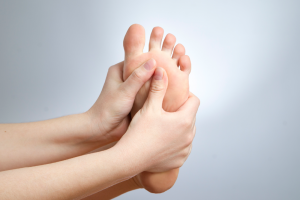Nerves of Steel 10 Ways To Reduce And Relieve Diabetic Neuropathy Pain
Diabetic neuropathy treatment options that eliminate the pain, tingling, numbness and other symptoms that come along with diabetic nerve issues of the feet.
Living with diabetes presents a new battle every day, one of which is pain, numbness and tingling of the limbs caused by diabetic peripheral neuropathy (or the loss of sensation in the arms, hands, legs and feet due to nerve damage). The uncomfortable feelings affect about 70 percent of people with diabetes and can have a direct impact on a diabetic patient’s mood, sleeping habits, working style and even overall quality of life.
There are prescription medications on the market that can help relieve neuropathy pain, but WebMD states these medications generally only ease 30 to 50 percent of the symptoms. To take care of the rest and prevent the condition from progressing, doctors suggest the following recommendations:
Control Your Blood Sugar Levels
Unfortunately, already damaged nerves cannot be fixed. However, you can decrease your chance of destroying more nerves (which will increase your peripheral neuropathy pain) by managing your diabetes condition and keeping your blood sugar levels in a healthy range. Doing so can reduce your risk of future nerve damage by over 60%, says the National Institute of Diabetes and Digestive and Kidney Diseases.
Ways to keep your blood sugar in check and within the recommended hemoglobin A1C reading of 7 percent or less include eating a diet high in whole grains and vegetables, managing stress, managing your body weight and regularly exercising. However, experts warn its better to gradually improve your blood sugar levels; a rapid drop can actually make nerve pain worse.
Bathe In Warm Water
Soaking in a warm bath or indulging in a foot soak is relaxing for your entire body, and it has the added benefit of improving circulation, which can instantly relieve pain associated with peripheral neuropathy. But because diabetes can cause loss of sensation, including the ability to feel hot and cold, you should use a thermometer or the help of a friend or loved one to check the water temperature before diving in.
Increase Your Vitamin D Intake
Research has shown that vitamin D, which your skin naturally produces in response to sunlight, may help relieve symptoms of neuropathy and diabetic foot pain. It’s difficult to get enough of the essential nutrient from sun exposure and diet, however, so doctors recommend taking a daily dose of a vitamin D supplement (600 to 800 IU), which studies have shown can significantly reduce peripheral neuropathy symptoms in as little as two months.
Incorporate A B Vitamin Complex Into Your Daily Routine
In addition to inspecting your feet on a daily basis, you may want to try adding a B vitamin complex into your routine. A lack of B12 has been linked to nerve damage, and B6 assists the brain in its production of chemicals that send information through our bodies.
Be More Physically Active
It might sound counterintuitive to work out the limbs that are causing you pain, but exercise actually has several pain-relieving benefits for those suffering from diabetic peripheral neuropathy.
- Exercise helps control blood sugar levels, which slows nerve damage and therefore helps decrease nerve pain.
- Physical activity increases circulation, which reduces nerve pain.
- Exercise boosts your mood and is a natural stress reliever, which helps relieve some of the discomfort.
If activities such as jogging and traditional sports are too painful, try activities with less muscle impact like swimming or bike riding.
Try A Prescription Strength Capsaicin Patch
Capsaicin is the active component of chili peppers that causes the vegetable to be hot and spicy, and it believe it or not, it can go a long way in reducing neuropathic pain. Studies have shown that wearing an 8 percent capsaicin patch reduces pain levels by as much as 30 percent after just a couple of weeks. You could also try applying a topical capsaicin cream like Zostrix or Capsagel to your sore limbs, but because they contain much lower doses of the active ingredient (0.1 percent), their pain-relieving power isn’t as intense as the prescription-strength capsaicin patches.
However, capsaicin isn’t tolerable for everyone. “Capsaicin works, but it is very hard for people with a burning pain from neuropathy because it really stings and burns. It just magnifies the pain," Robert Gerwin, M.D. told Diabetic Living. The burning will decrease after your body builds a tolerance (it works by eliminating one of the chemicals that initiates pain) but it takes three to five applications per day for up to a week or 10 days before the tolerance sets in. If you stop using the cream, even for a day, the burning sensation will return.
Apply Lidocaine
Just like with capsaicin, lidocaine can be applied to the body via a patch — but it will not create initial burning and stinging like capsaicin. Ongoing use of this treatment can reduce pain by up to 50 percent, according to an NCBI study.
Try Alpha-Lipoic Acid Infusions
Alpha-lipoic acid not only helps protect against future nerve damage, it is believed to help regulate blood sugar and therefore ease nerve pain. Our bodies naturally produce small amounts of the antioxidant, but intravenous infusions of the acid have been shown to significantly reduce neuropathic pain. You can also try an oral supplement of alpha-lipoic acid, but further studies are needed to prove the efficacy of this method.
Try Complementary Medicine Techniques, Such As Acupuncture
Complementary medicine isn’t for everyone, but millions of patients suffering from peripheral neuropathy have found relief via acupuncture, acupressure and reflexology. These techniques, which rely on pressure and painless insertion of needles into the body’s meridians (or nerve pathways), can help lower stress hormones, increase circulation and reduce inflammation in the body.
READ MORE: How Acupuncture Can Help Relieve Foot Pain
Additionally, you could try a TENS patch, which sends a mild electric current through your body that fatigues the nerves and makes them too tired to process pain. This method is a common treatment choice for mild peripheral neuropathy pain.
Manage Stress, Depression and Anxiety
Your brain and your body are linked more than you might think, meaning that stress, depression and anxiety have a direct impact on pain. The more emotionally unstable or unhappy you are, the more your diabetic peripheral neuropathy will physically affect you and cause intense pain. Considering the nerve condition is strongly associated with anxiety and depression, it’s important to engage in relaxation techniques like breathing exercises, massage, yoga and visualizing in addition to recommended antidepressants or other types of mood altering medication — all of which can significantly improve your mood, reduce your pain, and make dealing with diabetic peripheral neuropathy much easier in the long run.
Notice concerning medical entries:
Articles having medical content shall serve exclusively for the purpose of general information. Such articles are not suitable for any (self-) diagnosis and treatment of individual illnesses and medical indications. In particular, they cannot substitute for the examination, advice, or treatment by a licensed physician or pharmacist. No replies to any individual questions shall be effected through the articles.






